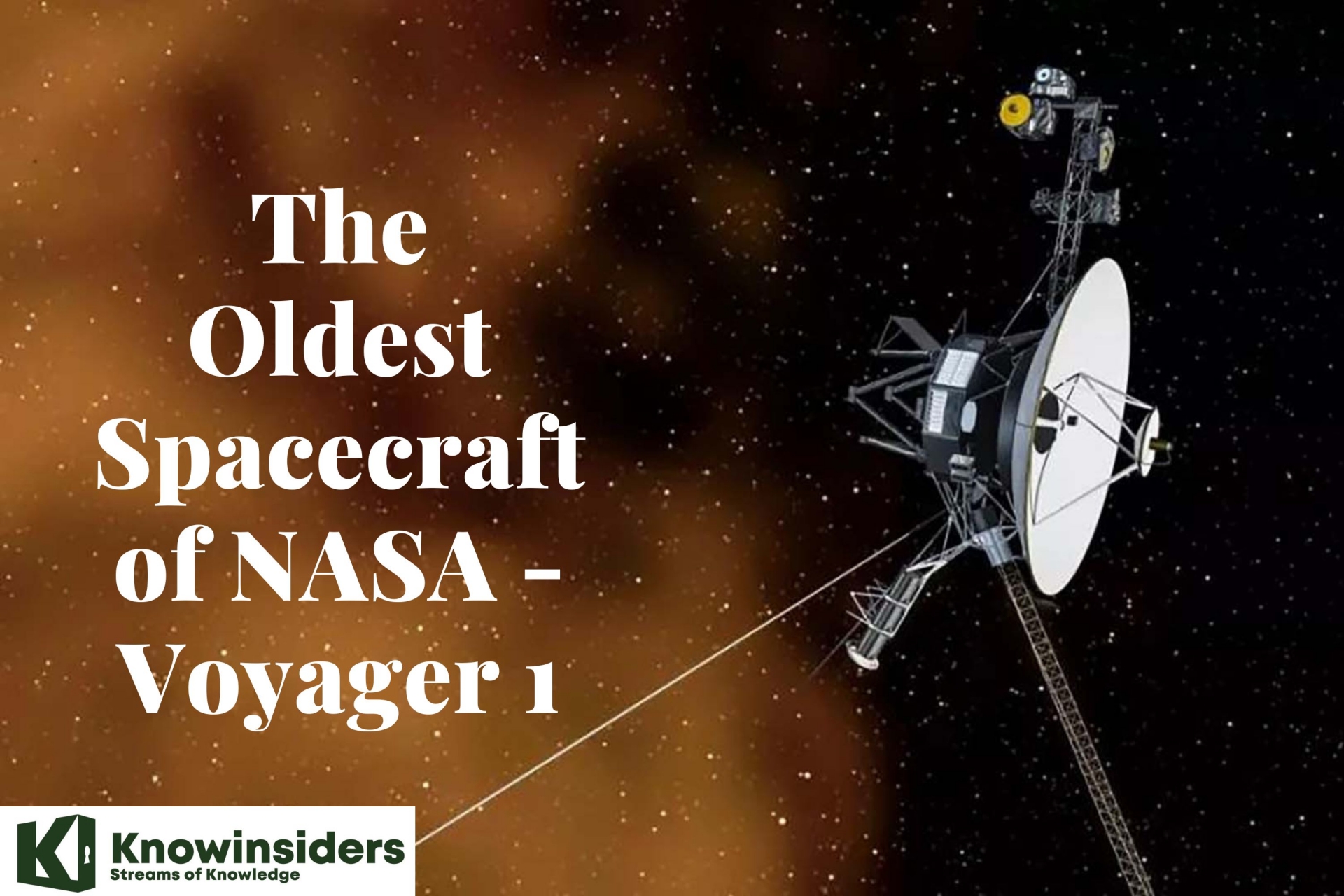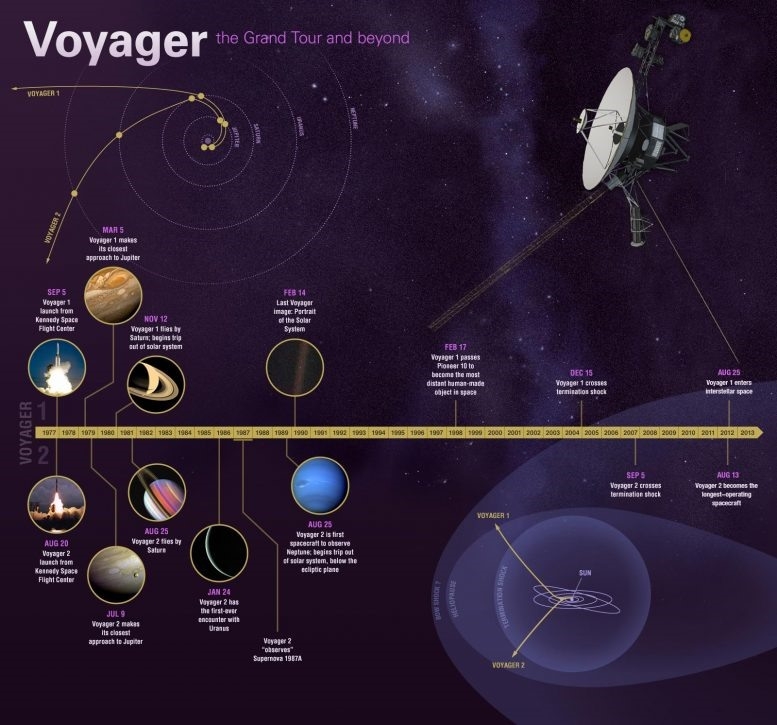What is the Oldest Spacecraft of NASA - Voyager 1
 |
| The Oldest Spacecraft of NASA - Voyager 1 |
| Table of Content |
NASA launched Voyager 2 and 1 - twin versions - on August 20 and September 5, 1977. The two spacecraft are still on a journey to explore space and are the only duo of probes to explore space. interstellar space after passing the heliosphere. The heliosphere is a protective bubble created by the Sun's magnetic field and a stream of charged particles called the solar wind.
Ships 1 and 2 have explored every giant planet at the outer edge of the solar system (Jupiter, Saturn, Uranus, and Neptune), 48 moons, and their unique magnetic and ring systems.
As of April 2020, Voyager 1 is 22.4 billion kilometers from the Sun and continues its mission to explore distant places in the universe.
What is Voyager 1?
Voyager 1 is a spacecraft that was designed to study the outer solar system. Its initial objectives included a flyby of Jupiter and Saturn.
Voyager 1 launched on Sept. 5, 1977, after its twin spacecraft, Voyager 2, which launched on Aug. 20, 1977. Although Voyager 1 launched after Voyager 2, it overtook its sibling spacecraft later that year due to a faster route.
Voyager 1 performed a flyby of Jupiter on March 5, 1979 and a Saturn flyby on Nov. 12, 1980. Planetary encounters concluded in 1989, and the Voyager missions then shifted to the Voyager Interstellar Mission (VIM), which pushed to explore the outer limits of our solar system and beyond. The new mission began on Jan. 1, 1990.
On Feb. 17, 1998, Voyager 1 overtook Pioneer 10 to become the most distant human-made object, and on Aug. 1, 2012, Voyager 1 entered interstellar space, becoming the first human-made object to do so. According to NASA, no other spacecraft has traveled farther than Voyager 1, and no other spacecraft has flown longer than the Voyager twin space probes. Voyager 1 is also credited with taking the first and only (so far) “family portrait” of our solar system.
Mission Objective
 |
| Voyager Interstellar Mission |
The mission objective of the Voyager Interstellar Mission (VIM) is to extend the NASA exploration of the solar system beyond the neighborhood of the outer planets to the outer limits of the Sun's sphere of influence, and possibly beyond. This extended mission is continuing to characterize the outer solar system environment and search for the heliopause boundary, the outer limits of the Sun's magnetic field, and the outward flow of the solar wind. Penetration of the heliopause boundary between the solar wind and the interstellar medium will allow measurements to be made of the interstellar fields, particles, and waves unaffected by the solar wind.
How big is Voyager? How much does it weigh?
The Voyager spacecraft's weight, including hydrazine, at launch, was 815 kg or about 1797 pounds. It was almost the weight and size of a sub-compact car. The current approximate weight of Voyager 1 is 733 kg and Voyager 2 is 735 kg. The difference is in the amount of hydrazine remaining. Hydrazine is being used to control the spacecraft's attitude.
The spacecraft, without the various booms, could fit inside a cube that is about 4 meters on each side. The approximate measurements of the different structures follow - please refer to the spacecraft picture on the above website.
• The high gain antenna is 3.7 meters across (diameter).
• The magnetometer boom is 13 meters long
• The two Planetary Radio Astronomy and Plasma Wave antenna are 10 meters long.
• The Radioisotope Thermoelectric Generator boom is 3.7 meters long
• The science instrument boom (near the top of the picture) is 3 meters long.
• The Bus Housing Electronics is about 1.8 meters in diameter.
The spacecraft height - from the top of the reflector structure in the middle of the high gain antenna to the bottom of the triangular feet below the bus housing electronics - is about 3.8 meters.
How Old is NASA's Voyager Now?
Even though it's been 45 years, Voyager's electronics are still functioning properly. The computer system on Voyager does not require much power. Information collected by the spacecraft is recorded on tape from eight tracks, then sent back to Earth by a machine with the same energy consumption as a refrigerator light bulb.
It is expected that after 2030, Voyager will no longer be able to communicate with Earth. However, the spacecraft still has its final mission when carrying a 12-inch gold-plated plate, containing information about the Earth including 115 pictures, greetings in 55 languages, sound effects of wind, rain, etc. human heartbeat and 90 minute track.
Over the next 20,000 years, Voyager 1 and 2 will pass by Proxima Centauri, the closest star to us. Next, the two spacecraft will orbit the galaxy for millions of years in an almost intact state even if the Sun collapses.
How Long will Voyager 1Bbattery Last?
Voyager 1 is expected to keep working until 2025 when it will finally run out of power. None of this would be possible without the spacecraft's three batteries filled with plutonium-238. In fact, Most of what humanity knows about the outer planets came back to Earth on plutonium power.
What star will Voyager 1 reach in 40000 years?
 |
| Photo: khoahoc |
The Voyagers have enough electrical power and thruster fuel to keep its current suite of science instruments on until at least 2025. By that time, Voyager 1 will be about 13.8 billion miles (22.1 billion kilometers) from the Sun and Voyager 2 will be 11.4 billion miles (18.4 billion kilometers) away. Eventually, the Voyagers will pass other stars. In about 40,000 years, Voyager 1 will drift within 1.6 light-years (9.3 trillion miles) of AC+79 3888, a star in the constellation of Camelopardalis which is heading toward the constellation Ophiuchus. In about 40,000 years, Voyager 2 will pass 1.7 light-years (9.7 trillion miles) from the star Ross 248 and in about 296,000 years, it will pass 4.3 light-years (25 trillion miles) from Sirius, the brightest star in the sky. The Voyagers are destined—perhaps eternally—to wander the Milky Way.


























